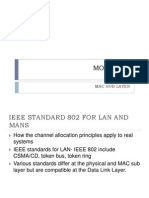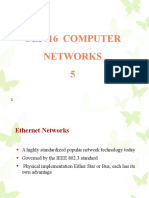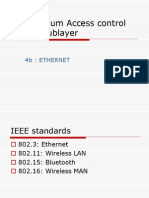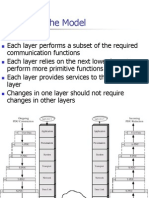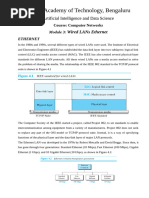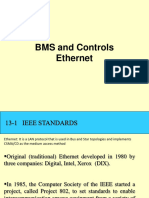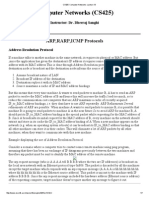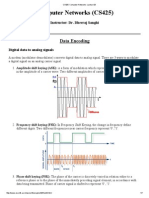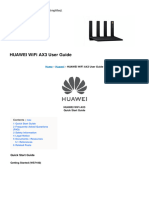Computer Networks (CS425) : IEEE 802.3 and Ethernet
Uploaded by
Anish VeettiyankalComputer Networks (CS425) : IEEE 802.3 and Ethernet
Uploaded by
Anish Veettiyankal11/6/2014
CS425: Computer Networks: Lecture 06
Computer Networks (CS425)
Instructor: Dr. Dheeraj Sanghi
Prev| Next| Index
IEEE 802.3 and Ethernet
Very popular LAN standard.
Ethernet and IEEE 802.3 are distinct standards but as they are very similar to one another these words are used interchangeably.
A standard for a 1-persistent CSMA/CD LAN.
It covers the physical layer and MAC sublayer protocol.
Ethernet Physical Layer
A Comparison of Various Ethernet and IEEE 802.3 Physical-Layer Specifications
Characteristic
Ethernet Value
10Base2
10
Baseband
185
IEEE 802.3 Values
10BaseT
10
Baseband
100
Data rate (Mbps)
Signaling method
Maximum segment length
(m)
Media
10
Baseband
500
10Base5
10
Baseband
500
10BaseF
10
Baseband
2,000
10 Base -TX
100
Baseband
100
50-ohm coax
(thick)
50-ohm coax
(thick)
50-ohm coax
(thin)
Unshielded twisted-pair
cable
Fiber-optic Cat 5 UTP
Unshielded twisted-pair cable
Nodes/segment
Topology
100
Bus
100
Bus
30
Bus
1024
Star
1024
Point-topoint
Bus
Bus
100BaseT4
100
Baseband
100
10Base5 means it operates at 10 Mbps, uses baseband signaling and can support segments of up to 500 meters. The 10Base5 cabling is popularly called the Thick
Ethernet. Vampire taps are used for their connections where a pin is carefully forced halfway into the co-axial cable's core as shown in the figure below. The 10Base2 or
Thin Ethernet bends easily and is connected using standard BNC connectors to form T junctions (shown in the figure below). In the 10Base-T scheme a different kind of
wiring pattern is followed in which all stations have a twisted-pair cable running to a central hub (see below). The difference between the different physical connections is
shown below:
(a) 10Base5 (b)10Base2 (c)10Base-T
All 802.3 baseband systems use Manchester encoding , which is a way for receivers to unambiguously determine the start, end or middle of each bit without reference to
an external clock. There is a restriction on the minimum node spacing (segment length between two nodes) in 10Base5 and 10Base2 and that is 2.5 meter and 0.5 meter
respectively. The reason is that if two nodes are closer than the specified limit then there will be very high current which may cause trouble in detection of signal at the
receiver end. Connections from station to cable of 10Base5 (i.e. Thick Ethernet) are generally made using vampire taps and to 10Base2 (i.e. Thin Ethernet) are made
using industry standard BNC connectors to form T junctions. To allow larger networks, multiple segments can be connected by repeaters as shown. A repeater is a
physical layer device. It receives, amplifies and retransmits signals in either direction.
Note: To connect multiple segments, amplifier is not used because amplifier also amplifies the noise in the signal, whereas repeater regenerates signal after removing the
noise.
IEEE 802.3 Frame Structure
Preamble Start of Frame Delimiter Dest. Address Source Address Length 802.2 Header+Data Frame Checksum
(7 bytes)
(1 byte)
(2/6 bytes)
(2/6 bytes)
(2 bytes) (46-1500 bytes)
(4 bytes)
http://www.cse.iitk.ac.in/users/dheeraj/cs425/lec06.html
1/3
11/6/2014
CS425: Computer Networks: Lecture 06
A brief description of each of the fields
Preamble :Each frame starts with a preamble of 7 bytes, each byte containing the bit pattern 10101010. Manchester encoding is employed here and this enables the
receiver's clock to synchronize with the sender's and initialise itself.
Start of Frame Delimiter :This field containing a byte sequence 10101011 denotes the start of the frame itself.
Dest. Address :The standard allows 2-byte and 6-byte addresses. Note that the 2-byte addresses are always local addresses while the 6-byte ones can be local or
global.
2-Byte Address
- Manually assigned address
Individual(0)/Group(1) Address of the machine
(1 bit)
(15 bits)
6-Byte Address
- Every Ethernet card with globally unique address
Individual(0)/Group(1) Universal(0)/Local(1) Address of the machine
(1 bit)
(1 bit)
(46 bits)
Multicast : Sending to group of stations. This is ensured by setting the first bit in either 2-byte/6-byte addresses to 1.
Broadcast : Sending to all stations. This can be done by setting all bits in the address field to 1.All Ethernet cards(Nodes) are a member of this group.
Source Address :Refer to Dest. Address. Same holds true over here.
Length : The Length field tells how many bytes are present in the data field, from a minimum of 0 to a maximum of 1500. The Data and padding together can be
from 46bytes to 1500 bytes as the valid frames must be at least 64 bytes long, thus if data is less than 46 bytes the amount of padding can be found out by length
field.
Data :Actually this field can be split up into two parts - Data(0-1500 bytes) and Padding(0-46 bytes).
Reasons for having a minimum length frame :
1. To prevent a station from completing the transmission of a short frame before the first bit has even reached the far end of the cable, where it may collide with
another frame. Note that the transmission time ought to be greater than twice the propagation time between two farthest nodes.
transmission time for frame > 2*propagation time between two farthest nodes
2. When a transceiver detects a collision, it truncates the current frame, which implies that stray bits and pieces of frames appear on the cable all the time.
Hence to distinguish between valid frames from garbage, 802.3 states that the minimum length of valid frames ought to be 64 bytes (from Dest. Address to
Frame Checksum).
Frame Checksum : It is a 32-bit hash code of the data. If some bits are erroneously received by the destination (due to noise on the cable), the checksum computed
by the destination wouldn't match with the checksum sent and therefore the error will be detected. The checksum algorithm is a cyclic redundancy checksum (CRC)
kind. The checksum includes the packet from Dest. Address to Data field.
Ethernet Frame Structure
Preamble Dest. Address Source Address Type
Data
Frame Checksum
(8 bytes) (2/6 bytes)
(2/6 bytes)
(2 bytes) (46-1500 bytes)
(4 bytes)
A brief description of the fields which differ from IEEE 802.3
Preamble :The Preamble and Start of Frame Delimiter are merged into one in Ethernet standard. However, the contents of the first 8 bytes remains the same in
both.
Type :The length field of IEEE 802.3 is replaced by Type field, which denotes the type of packet being sent viz. IP, ARP, RARP, etc. If the field indicates a value
less than 1500 bytes then it is length field of 802.3 else it is the type field of Ethernet packet.
Truncated Binary Exponential Back off
In case of collision the node transmitting backs off by a random number of slots , each slot time being equal to transmission time of 512 bits (64 Byte- minimum size of a
packet) in the following fashion:
No of Collision
Random No of slots
1st
0-1
2nd
0-3
3rd
0-7
10th
0-1023
--------------------------------------------11th
0-1023
12th
0-1023
|
16th
|
0-1023
In general after i collisions a random number between 0-2^i-1 is chosen , and that number of slots is skipped. However, after 10 collisions have been reached the
randomization interval is frozen at maximum of 1023 slots. After 16 collisions the controller reports failure back to the computer.
http://www.cse.iitk.ac.in/users/dheeraj/cs425/lec06.html
2/3
11/6/2014
CS425: Computer Networks: Lecture 06
5-4-3 Rule
Each version of 802.3 has a maximum cable length per segment because long propagation time leads to difficulty in collision detection. To compensate for this the
transmission time has to be increased which can be achieved by slowing down the transmission rate or increasing the packet size, neither of which is desirable. Hence to
allow for large networks, multiple cables are connected via repeaters. Between any two nodes on an Ethernet network, there can be at most five segments, four repeaters
and three populated segments (non-populated segments are those which do not have any machine connected between the two repeaters). This is known as the 5-4-3 Rule.
Image References:
http://homepages.ius.edu/rwisman/b438/Html/4-14.jpg
back to top
Prev| Next | Index
http://www.cse.iitk.ac.in/users/dheeraj/cs425/lec06.html
3/3
You might also like
- CCISO Certified Chief Information Security Officer All-In-One Exam Guide100% (2)CCISO Certified Chief Information Security Officer All-In-One Exam Guide862 pages
- The Gilliam Autism Rating Scale GARS - 2 A Pilot S100% (1)The Gilliam Autism Rating Scale GARS - 2 A Pilot S2 pages
- Difference Between Ethernet 2 Frame and 802.3 Frame0% (1)Difference Between Ethernet 2 Frame and 802.3 Frame2 pages
- Wired Lans and Ethernet: 01204325: Data Communication and Computer NetworksNo ratings yetWired Lans and Ethernet: 01204325: Data Communication and Computer Networks53 pages
- Ethernet: Fast Ethernet Gigabit EthernetNo ratings yetEthernet: Fast Ethernet Gigabit Ethernet47 pages
- Physical and Data Link Layers (1 & 2) : Ethernet (Network Interfce Card)No ratings yetPhysical and Data Link Layers (1 & 2) : Ethernet (Network Interfce Card)50 pages
- Computer Networks Assignment No. 02: Ponraj. P Iii Bca C 0822JC32 02.08.2010No ratings yetComputer Networks Assignment No. 02: Ponraj. P Iii Bca C 0822JC32 02.08.201024 pages
- Ethernet: - IEEE-Institute of Electrical and ElectronicsNo ratings yetEthernet: - IEEE-Institute of Electrical and Electronics27 pages
- Net - 006 Chapter 4 - Current Ethernet SpecificationsNo ratings yetNet - 006 Chapter 4 - Current Ethernet Specifications26 pages
- Ethernet: Oakton Community College CIS 238No ratings yetEthernet: Oakton Community College CIS 23816 pages
- Ethernet: An Introduction: Fast Ethernet Operates 10 Times Faster, I.e., at 100 Mbps. Recently, There HasNo ratings yetEthernet: An Introduction: Fast Ethernet Operates 10 Times Faster, I.e., at 100 Mbps. Recently, There Has4 pages
- Ethernet: Fast Ethernet Gigabit EthernetNo ratings yetEthernet: Fast Ethernet Gigabit Ethernet47 pages
- LAN Topologies and Media Access ControlNo ratings yetLAN Topologies and Media Access Control35 pages
- IT-604: Internet Architecture & Protocols: Dr. Ihsan UllahNo ratings yetIT-604: Internet Architecture & Protocols: Dr. Ihsan Ullah22 pages
- Computer Networks Computer Networks: Taiz University, 2021 Taiz University, 2021No ratings yetComputer Networks Computer Networks: Taiz University, 2021 Taiz University, 202154 pages
- 4b Ethernet - Medium Access Control SublayerNo ratings yet4b Ethernet - Medium Access Control Sublayer61 pages
- E-Note 28022 Content Document 20241125120849PMNo ratings yetE-Note 28022 Content Document 20241125120849PM109 pages
- Point-To-Point vs. Shared Channel Communication in LansNo ratings yetPoint-To-Point vs. Shared Channel Communication in Lans22 pages
- General Fill in The Blanks' Questions (: May Have Some Duplicates)No ratings yetGeneral Fill in The Blanks' Questions (: May Have Some Duplicates)4 pages
- Computer Networking: An introductory guide for complete beginners: Computer Networking, #1From EverandComputer Networking: An introductory guide for complete beginners: Computer Networking, #14.5/5 (2)
- Computer Networks (CS425) : Unix Socket Programming (Contd..)No ratings yetComputer Networks (CS425) : Unix Socket Programming (Contd..)6 pages
- Computer Networking Interview Question and Answer PDFNo ratings yetComputer Networking Interview Question and Answer PDF30 pages
- Computer Networks (CS425) : Transport Layer Protocol (Continued)No ratings yetComputer Networks (CS425) : Transport Layer Protocol (Continued)4 pages
- Jason Dela Cruz Jose": IT Engineer / Systems EngineerNo ratings yetJason Dela Cruz Jose": IT Engineer / Systems Engineer3 pages
- Computer Networks (CS425) : Unix Socket ProgrammingNo ratings yetComputer Networks (CS425) : Unix Socket Programming4 pages
- Computer Networks (CS425) : Transport Layer Protocol-Implementation IssuesNo ratings yetComputer Networks (CS425) : Transport Layer Protocol-Implementation Issues5 pages
- Computer Networks (CS425) : Transport Layer ProtocolNo ratings yetComputer Networks (CS425) : Transport Layer Protocol3 pages
- Computer Networks (CS425) : Instructor: Dr. Dheeraj SanghiNo ratings yetComputer Networks (CS425) : Instructor: Dr. Dheeraj Sanghi7 pages
- Computer Networks (CS425) : ARP, RARP, ICMP ProtocolsNo ratings yetComputer Networks (CS425) : ARP, RARP, ICMP Protocols7 pages
- Computer Networks (CS425) : Data EncodingNo ratings yetComputer Networks (CS425) : Data Encoding7 pages
- Computer Networks (CS425) : Instructor: Dr. Dheeraj SanghiNo ratings yetComputer Networks (CS425) : Instructor: Dr. Dheeraj Sanghi6 pages
- Computer Networks (CS425) : Routing AlgorithmsNo ratings yetComputer Networks (CS425) : Routing Algorithms5 pages
- Computer Networks (CS425) : ISO-OSI 7-Layer Network ArchitectureNo ratings yetComputer Networks (CS425) : ISO-OSI 7-Layer Network Architecture5 pages
- Cisco - Labs 1.6.1 - Packet Tracer Skills Integration ChallengeNo ratings yetCisco - Labs 1.6.1 - Packet Tracer Skills Integration Challenge3 pages
- An Overview of Software-Defined Network: Presenter: Xitao WenNo ratings yetAn Overview of Software-Defined Network: Presenter: Xitao Wen44 pages
- Curriculum Structure Semester - VII: SHIVAJI UNIVERSITY, KOLHAPUR - Syllabus W.E.F. 2014 - 15No ratings yetCurriculum Structure Semester - VII: SHIVAJI UNIVERSITY, KOLHAPUR - Syllabus W.E.F. 2014 - 1535 pages
- Networks and System Administration Notes Tutorial All ChaptersNo ratings yetNetworks and System Administration Notes Tutorial All Chapters21 pages
- 3.2.4.9 Lab - Troubleshooting VLAN Configurations0% (1)3.2.4.9 Lab - Troubleshooting VLAN Configurations10 pages
- Fortinet Fortigate and Nozomi Networks Guardian: Deployment GuideNo ratings yetFortinet Fortigate and Nozomi Networks Guardian: Deployment Guide11 pages
- Chelsio Terminator 3 Unified Wire Engine White PaperNo ratings yetChelsio Terminator 3 Unified Wire Engine White Paper6 pages

































